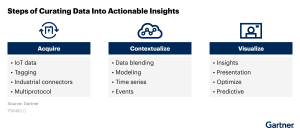The 3-Step Process of Contextualizing IoT and Manufacturing Data for Smart Factories
Gartner® Report
An overwhelming flow of manufacturing data
For nearly 10 years, industrials and manufacturers have been investing in the modernization of their tools, lines, and processes with new technologies and innovations like Internet of Things (IoT,) digital twins and artificial intelligence (AI) to increase capacity, efficiency, yield, and reliability. As IoT investments materialize in the factory, new data streams generate a plethora of data that are by nature raw, repetitive, uncurated, and unfiltered.
If these streams are driven by the well-known 4Vs (volume, velocity, variety, and veracity), achieving the 5th V (value) stills remain challenging, thus potentially leading to gaps in production performance, increases in operational expenses, and security vulnerabilities along with poor actionable data quality for decision-makers.
“26% of manufacturers indicated they have deployed IoT in full-scale production environments. However, the velocity and volume of IoT data also threaten to overwhelm these organizations’ manufacturing infrastructure and business processes and the skills of their people.”
Source: 2020 Gartner IoT Implementation Trends Survey
Increasing challenges
From these observations, Gartner identifies three major challenges for smart factories in its November 2021 report, “The 3-Step Process of Contextualizing IoT and Manufacturing Data to Enable Smart Factories”.
- “Internet of Things (IoT) data is not fully utilized because the volume being generated by physical assets like heat pumps, controllers and actuators makes generating and abstracting impactful insights difficult”.
- “Often IoT data is not fused with other manufacturing data such as information from the Manufacturing Execution System (MES), historian databases, Supervisory Control And Data Acquisition (SCADA) and Enterprise Resource Planning (ERP)”.
- “Manufacturing decision makers have a difficult time understanding data because of the poor structure or process of how the data is visualized”.
3-step process for smart factories to successfully benefit from IoT
As “not properly curating the IoT data with other manufacturing data will result in incomplete and inaccurate insights”, Gartner highlights three key steps manufacturing CIOs and IT leaders should follow to “implement a robust IoT-enabled data lake where both IoT and manufacturing data can be collected, contextualized, and visualized”.

Who should read this report; and why?
Smart factories’ CIOs, IT leaders and IT teams, as well as operational technology and production managers can immediately leverage the detailed guidelines shared in this report to:
- Identify how to capture the type of business insights required by each critical decision maker,
- Implement a data-collection engine that will curate and contextualize IoT data,
- Understand the definitions of hot, warm, and cold data to directly relate them to operational tasks,
- Anticipate the network effect of IoT data correlated with the growing number of IoT devices and manufacturing assets, and
- Establish a data lake that will efficiently combine both contextualized IoT data and manufacturing production data.
1 Gartner, “The 3-Step Process of Contextualizing IoT and Manufacturing Data to Enable Smart Factories”, By Scot Kim, 11 November 2021.
![]()
Gartner Disclaimer:
This graphic was published by Gartner, Inc. as part of a larger research document and should be evaluated in the context of the entire document. The Gartner document is available upon request Kerlink.
GARTNER is a registered trademark and service mark of Gartner, Inc. and/or its affiliates in the U.S. and internationally and is used herein with permission. All rights reserved.


